
MANUFACTURER'S SPECIFICATIONS
FM Tuner Section
Usable Sensitivity: Mono, 2.5 µV (13.2 7.8 µV (23.0 d Bf).
50-dB Quieting: Mono, 5.5 µV (20.0 dBf); Stereo, 55 µV (40 dBf).
Signal-to-Noise Ratio: Mono, 75 dB; Stereo, 70 dB.
THD: Mono, 0.06 per cent wide; 0.2 percent narrow (1 kHz); Stereo, 0.1 percent wide, 0.5 percent narrow (1 kHz).
Capture Ratio: 0.8 dB wide, 1.5 dB narrow.
Selectivity: 45 dB wide, 75 dB narrow.
I.F. Rejection: 80 dB.
Image Rejection: 75 dB.
Spurious Rejection: 90 dB.
AM Suppression: 55 dB wide, 50 dB narrow.
Frequency Response: 30 Hz to 15 kHz, ±1.0
Stereo Separation: Wide, 45 dB @ 1 kHz, 40 dB @ 10 kHz; Narrow, 35 dB @1 kHz, 30 dB@10 kHz.
Sub-Carrier Rejection: 60 dB.
SCA Rejection: 70 dB.
Muting Level: 23 dBf.
Output Level: Fixed, 450 mV; Variable, 0-1.2 V.
AM Tuner Section
Usable Sensitivity: 45 dB (bar antenna).
Selectivity: 25 dB.
TH D: 1.0 per cent.
SIN: 50 dB.
Image Rejection: 40 dB.
I.F. Rejection: 70 dB.
Rejection: Output Level: Fixed, 150 mV; Variable, 0 to 400 mV.
General Specifications
Dimensions: 16 3/8 in. (42.5 cm) W x 6 3/8 in. (17.1 cm) H x 10 1/8 in. (26.4 cm) D.
Weight: 16 1/2 lbs. (7.5 kg).
Power Consumption: 18 W.
Price: $260.00.
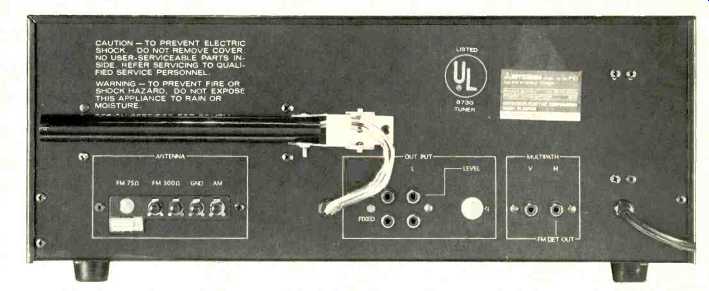
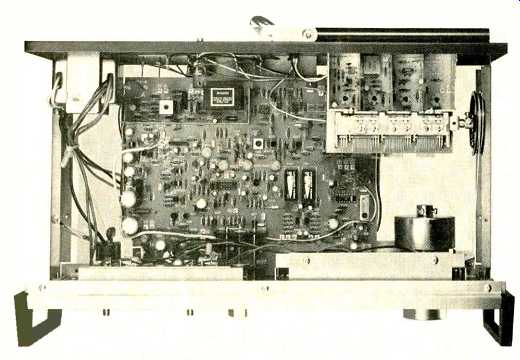
Part of the joy that comes from evaluating new audio products occurs when, every now and again, we run into an unexpectedly fine product at an unusually low price-with no forewarning. That is exactly the sort of thing that happened when we unpacked and began measuring the Mitsubishi Model DA-F10 tuner. From the moment we removed the little unit from its carton we sensed that here was a different sort of tuner. The tuning dial treatment was the first thing that attracted our attention. Instead of the usual long, linear dial scale, frequencies are printed on a circular wheel only part of which is visible in the dial area window. Turning the tuning knob at the lower right provides vernier rotation of this dial wheel, which is calibrated linearly (or should I say circularly) at every MHz. The dial pointer itself is really just a stationary graticule marker. Clearly, if this dial wheel were extended to its full perimeter length, it would be quite long indeed, and therefore very precise tuning is made possible with this novel arrangement. If you've seen any of those "nostalgia" radios around (which, I believe are replicas of vintage-20s Philco "cathedral" cabinet sets), the similarity of tuning method is immediately apparent. But make no mistake-this is no archaic tuner. It is, in fact, extremely advanced for its low price.
To either side of the "dial-wheel" are indicator lights-one to show stereo reception, the other identified as "lock" which comes on when stations (FM) have been properly center-tuned using the center-of-channel meter located in a matching window at the left of the panel along with the signal strength meter.
Controls along the bottom of the panel include a toggle-type power On/Off switch, a selectivity selector switch with positions for wide and narrow i.f. bandwidth, a selector switch with positions for AM, auto FM, mono FM, and mono.
FM with muting defeated. This switching arrangement makes it impossible to tune to a stereo FM station without interstation muting, but that is not as serious as it might seem since, as we later learned, muting threshold is fixed at around 8.0 µV (23.3 dBf), and any stereo signals likely to be received at lower signal strengths than that would be unlistenable because of high noise content anyway. The aforementioned tuning knob at the lower right of the front panel completes the layout.
The rear panel of the Mitsubishi DA-F10 is equipped with the usual 75-ohm and 300-ohm antenna terminals for FM, and ground and hot AM external antenna terminals. A cable clamp beneath the 75-ohm terminal retains the coaxial transmission line in place and grounds its shield when that type of lead-in cable is used. A pivotable AM ferrite-bar antenna is located near the two sets of output jacks--one pair providing fixed level, the other variable by means of an adjacent screwdriver control which enables the user to set tuner output levels to match other program sources fed to the amplifier or preamplifier in the system. Vertical and horizontal 'scope output jacks are also provided, the latter also serving as a detector output for connection to any form of four-channel adaptor that is likely to appear on the market in the future.
Although no schematic diagram was supplied with our sample, examination of the internal layout of the chassis disclosed a neatly constructed separate front end, which utilizes a four-gang FM tuning capacitor and a three-gang AM (yes, we said three-gang) tuning capacitor, and extensive interstage shielding. The main tuner board (i.f., multiplex, AM, and audio sections) is a model of neat r.f. layout, and each and every part is identified by legible, schematic-symbol silk screening. In evidence was a six-pole, linear phase, 10.7-MHz i.f. filter block in the final section of the FM--i.f. stages and a pair of low-pass filter blocks in the multiplex decoder section for subcarrier product suppression and a phase-lock loop circuit in the multiplex section. Total solid-state complement includes five ICs, 38 transistors, and 19 diodes.
Laboratory Measurements
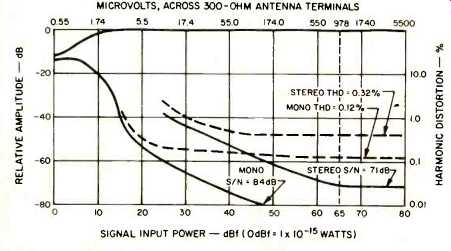
Fig. 1-Mono and stereo quieting and distortion characteristics for the Mitsubishi
DA-F10 tuner FM section in the Narrow i.f. position.
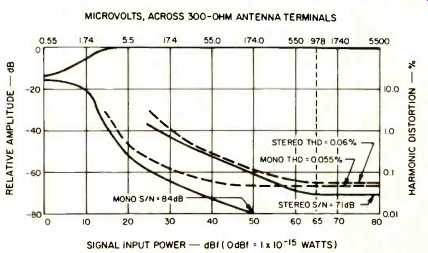
Fig. 2-Mono and stereo quieting and distortion characteristics in the Wide
i.f. position.
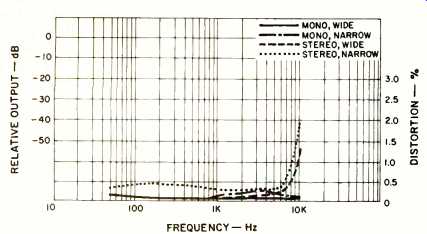
Fig. 3-Distortion vs. frequency.
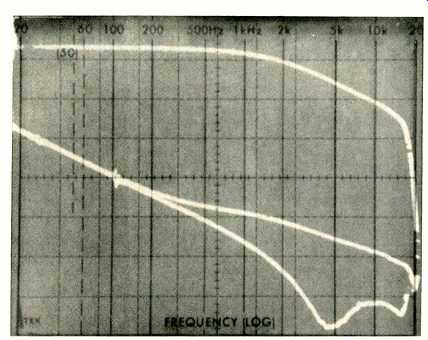
Fig. 4-Stereo separation vs. frequency. Upper trace is the desired output;
lower traces show crosstalk to opposite channel with poorer high frequency
separation in the Narrow i.f. setting.
As we noted in describing the front-panel controls, this tuner has two bandwidth ranges in the FM i.f. section. The wide-band position is intended for use when ultra-low distortion reception is desired and when stations are not too close to each other on the dial to cause interference, since wide bandwidth must necessarily sacrifice adjacent and alternate channel selectivity to some degree. Since many of the measurements one would normally make on an FM tuner are affected by the bandwidth setting, it was necessary to repeat most of the significant measurements for each bandwidth switch setting. Figure 1 shows quieting and 1-kHz distortion as a function of signal strength, for both mono and stereo reception. For this narrow bandwidth setting, selectivity was 76 dB (alternate channel) while adjacent channel rejection was only 9 dB. Though S/N for mono and stereo remained the same for both bandwidth settings (84 dB mono; 71 dB stereo), distortion, as might be expected, was considerably higher than the figures we later obtained in the wide band position, namely 0.12 percent for mono and 0.32 percent for stereo.
Switching to the wide-band position, selectivity decreases to 45 dB (alternate channel), but, as can be seen in Fig. 2, distortion almost reaches the "vanishing point" with readings of 0.055 per cent in mono and 0.06 per cent in stereo. Both readings may well be influenced by whatever residual distortion components exist in our FM signal generator setup! Figure 3 includes multiple plots of distortion versus audio frequency, for mono and stereo, and for both bandwidth set tings. In the wide-band position, even 6 kHz THD in stereo was a very low 0.2 per cent, and there was no evidence of sub-carrier product leakage when this reading was taken.
Best mono usable sensitivity was obtained in the narrow position, with a reading of 2.5 µV (13.2 dBf) as claimed. In stereo, the usable sensitivity was limited by the stereo switching threshold which occurs at 8.0 µV (23.3 dBf) in the case of the "narrow" setting (10.0 µV or 25.2 dBf for the wide band position). The 50-dB quieting reading was the same for both bandwidth positions, 3.8 µV (16.8 dBf) for mono and 48 µV (38.8 dBf) for stereo-rather high in view of the other quieting parameters measured. Muting threshold was set to the same 8.0 µV, as was the stereo threshold. Capture ratio measured 1.4 dB in the wide i.f. setting and 0.9 dB in the narrow setting. The i.f. and image rejection ratios were 87 dB and 92 dB respectively, regardless of bandwidth settings.
As might be expected, stereo separation was materially affected by the bandwidth settings. In Fig. 4 we have plotted desired and undesired (cross-talk) response (including the built-in 75-microsecond de-emphasis characteristic) for each of the bandwidth settings. Desired channel output (upper trace) remains the same, of course, but when the narrow bandwidth setting was used, high frequency separation suffered (higher branch of the lower traces), decreasing to some 37 dB at 10 kHz as compared with an amazing 48 dB at that frequency when the wide-band mode was used. The low-frequency stereo separation exhibited a peculiar characteristic which we have never encountered previously, decreasing to 28 dB at 100 Hz for no apparent reason regardless of which bandwidth position was used. For practical listening purposes, however, 28 dB is quite adequate separation at such low frequencies. Overall frequency response was flat with 0.1 dB from 30 Hz to 10 kHz, with a 1.5 dB roll-off at 15 kHz caused, in part, by the action of the very effective carrier suppression filters in the multiplex decoder section.
The AM section of the tuner benefitted from the use of a somewhat more elaborate circuit than one normally finds in a tuner in this price category (or even in many higher priced tuners, for that matter) and had an ultimate signal-to-noise ratio of 51 dB, i.f. rejection of 70 dB as claimed, image rejection of 42 dB and a total harmonic distortion (at 30 percent modulation) of 0.8 percent. Using the internal antenna, sensitivity was 200 µV/meter. Selectivity was exactly 25 dB as claimed.
Use and Listening Tests
When the DA-F10 was used in the narrow-band setting, it delivered good FM reception which was indistinguishable from that of other tuners in this price range. It was only when we switched to the wide position (happily, there are some sections of our local FM dial that permitted us to use this band width) that the tuner really comes into its own. There is a clarity and openness of sound that is too good to believe. We have, of course, heard many other tuners which do as well or better, but these were generally in the over-$400.00 category and if we seem overly rapturous about this "sleeper" entry from Mitsubishi, it is simply because we are amazed at how much FM tuner value that company has been able to offer for this low, low price. While we were at first disturbed by the in corporation of the "lock" tuning feature (AFC by any other name is still AFC in our book), we can report that this feature is not too strong to prevent us from tuning to weak signals located near stronger ones and, even more important, in our sample at least, the "locked" setting corresponded perfectly with exact center-of-channel meter centering, and meter centering, in turn, corresponded precisely with the lowest-distortion tuning point. If one is going to feature AFC in an FM tuner these days, at least this one does not get in the way of proper tuning and proper reception. As a relative newcomer to the audio market, the name Mitsubishi may not be the easiest to pronounce, but I suspect that it will be one which will become very familiar if other products in their line are as value laden as this one.
-Leonard Feldman
( Audio magazine, Dec. 1977)
also see:
Mitsubishi DA-R35 AM/FM Receiver (Apr. 1982)
Mitsubishi LT-30 Turntable (June 1981)
Mitsubishi DP-EC1 direct-drive turntable (ad, June 1977)
= = = =